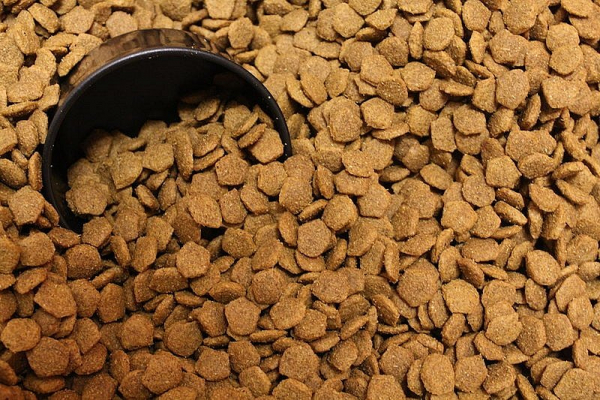Jak správně skladovat granule
Většina z nás využívá výhodných velkých balení granulí. Jak je ale doma delší dobu uchovávat, aniž by klesla jejich kvalita? Proč pak kupovat drahé kvalitní granule, kdybychom je skladováním znehodnotili?
With their appearance, the chinchillas just attract cuddling. They look a bit like plush toys and their eyes like beads give them a friendly and a kind-hearted look. But don’t let yourself be fooled! These rodents are definitely no phlegmatic pets with which you could do whatever you want. It is an arduous task to gain their trust and to tame them.


And some extremely coy individuals won’t let themselves be tamed at all. My friend had a chinchilla for fourteen years and even she never quite succeeded. In short, her chinchilla was at her most satisfied in her spacious cage where she possibly felt to be most safe. The chinchilla didn’t like to cuddle or to be scratched very much, not even at later age. Sometimes, she didn’t want to leave the cage at all.
Maybe this chinchilla wasn’t only coy, but also a bit moody…
Nevertheless, not every chinchilla is the same, so maybe it will be you who succeeds in taming yours quite a bit more. But how to go about it? Experienced breeders advise that at first, you should let the chinchilla to get used to a new environment. After you bring it home, you should give them time to find their footing and not stress them with unnecessary stimuli. Simply don’t disturb them and let them breathe for a while.
After a few days, you can start taming them. The animal should start getting used to you slowly, because chinchillas are quite sensitive to stress and nervous strain. Therefore, avoid their proximity and refrain from any fast or abrupt movements, since these scare the chinchillas. The best thing to do, is to leave the animal in the safety of their cage at first, and to start offering various treats through the grid. If your chinchilla doesn’t want to take the treats from your hand, lay them inside the cage, but leave your hand withing reach for them to get used to you. After some time, they will embolden and even take the food from your hand.
Maybe, after some time, you will achieve that the chinchilla allows you to stroke them. Breeders claim that these rodents usually prefer being stroked in the environment that is familiar to them – inside their cage rather than outside of it. The pinnacle of domestication is allegedly when the chinchilla climbs across your hand to your shoulder and nestles there. However, my friend never succeeded to do such a piece with her extremely shy chinchilla.
So if you want an animal mainly for cuddling and you feel that you won’t have patience for slow taming, you should consider whether a chinchilla is the right choice for you. Since even the domesticated animals aren’t especially cuddly. But if you’re someone whom it suits that their pet still keeps a little bit of ferocity and coyness at heart, then this rodent is the right companion for you.


Většina z nás využívá výhodných velkých balení granulí. Jak je ale doma delší dobu uchovávat, aniž by klesla jejich kvalita? Proč pak kupovat drahé kvalitní granule, kdybychom je skladováním znehodnotili?


Už jste ji viděli? Kočku, která vypadá jak vystřižená z hororu? Lykoi je nové kočičí plemeno připomínající svým vzhledem vlkodlaka. Pod děsivou maskou se ale skrývá inteligentní přátelská kočka se psí povahou.


Jak na pohodovou a bezpečnou koupačku se psem? Stačí se řídit několika jednoduchými pravidly a užijete si spolu pohodový den u vody.


Mají čtyři nohy, huňatou srst a neumí mluvit. Přesto mají desetitisíce fanoušků. Řeč je o pejscích. Přesněji o chlupáčích, kteří se díky svým pánům stali hvězdami českého Instagramu. Pojďme si společně ty nejzajímavější představit.


Chystáte se na dovolenou do Chorvatska a svého psího parťáka nechcete nechat doma? Vezměte ho s sebou! Poradím vám, které pláže navštívit, abyste si moře užili všichni.


Lososový olej je bezesporu jedním z nejoblíbenějších výživových doplňků pro psy. Jak ho používat a k čemu všemu je dobrý?


Tuto mohutně vypadající modrou krátkosrstou kočku lidé často zaměňují za tu britskou. Není se čemu divit, jsou si dost podobné vzhledem i povahou a v minulosti se spolu i křížily. Je to skvělý nenáročný společník s krásnou modrou srstí.


Věděli jste, že u nás existuje platforma pro pejskaře, kteří chtějí pomoct darováním psí krve nebo sami pro mazlíka takovou pomoc potřebují? Jak registr psích dárců krve funguje a kdo se může stát dárcem?


Na trhu je k dostání tolik různých pamlsků, že čert aby se v tom vyznal. Jak pro vašeho psího parťáka vybrat ten nejlepší?


Pražský krysařík, nebo taky libeňský srneček, je nejmenším a nejstarším českým plemenem. V jeho malém tělíčku dřímá velký temperament. Je to velmi čilý a oddaný společník.


Manx, tedy manská kočka, je starobylé, přirozeně vzniklé plemeno žijící na ostrově Man jako lovec myší i oblíbený domácí mazlíček. K nevýraznému zevnějšku obyčejné domácí kočky působí jejich extrémně krátký, nebo dokonce téměř žádný ocas jako pěst na...


Trend chovu domácích mazlíčků je záležitostí posledních 150 let. Ale jak to bude vypadat v těch následujících sto padesáti letech? S vývojem naší společnosti a jejích hodnot se do našeho hledáčku dostávají cirkusy, zoologické zahrady, přibývá lidí,...